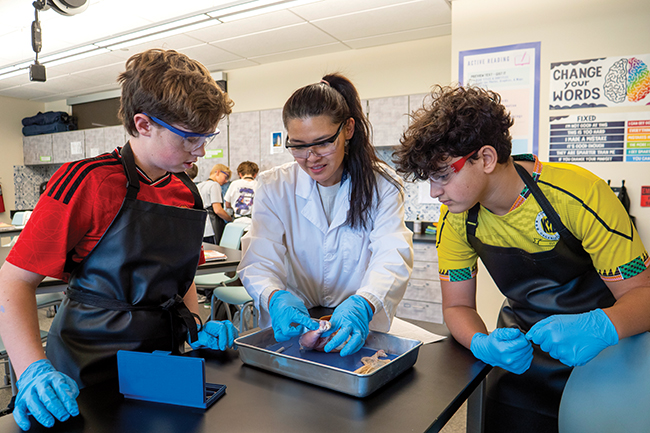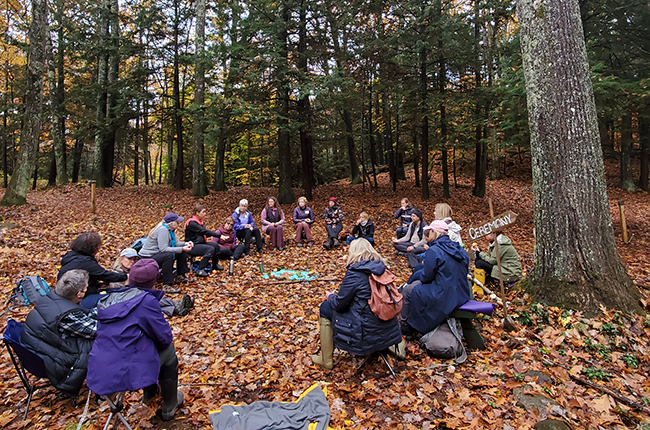Step into the School Year
05 Aug 2025
A look into Boulder’s excellent education
By Matt Maenpaa

The start of the school year is just around the corner, and fall colors are on the horizon. Whether you’re getting ready for your child’s first year or just looking for the best places for them to grow, the options seem endless. Boulder County is full of choices when it comes to public and private schools, showcasing excellence in traditional and alternative education so you can find what’s right for your family.
Once you’ve found the right school, navigating the rhythm of academics, activities, and family life becomes a rewarding balancing act. With the intensity of modern curricula and the sheer number of extracurriculars a kid can be involved in, finding a healthy balance is just as important for children as it is for adults.
For today’s Boulder families, the path to an excellent education begins with exploring the many enriching choices available. We explore alternative schools in the county, learn about how harassment and conflict are addressed, and discover ways to maintain your family’s health and balance.
Break from tradition
While most public schools in both Boulder Valley and St. Vrain Valley school districts adhere to a more traditional education, alternative education options have been popular here for decades. Educational philosophies like those in Waldorf and Montessori schools step out of traditional classroom models, providing structures that integrate various subjects rather than keeping them siloed.
Pressed against the foothills in North Boulder, Shining Mountain Waldorf School offers integrative education from early childhood through high school. The curriculum is based on five core elements: human development, joy of learning, learning by making—not memorizing, outdoor education and play, and conscious technology.
Students craft their own textbooks, with art integrated directly into lessons on reading, writing, sciences and math. The philosophy holds that nature breaks, play, physical activity and hands-on experience are crucial to helping students learn. Even with the increased presence of technology in the world, Shining Mountain’s staff focuses on more than a set of tools, but on how they can be used ethically and with intention.
“At Shining Mountain Waldorf School, our education is transformational. We don’t just teach science; our students become scientists. We don’t just teach art; our students become artists. We don’t just teach empathy; our students become humanitarians,” says school director Meg Gardner. “We educate the whole human being so that they can go out and shape our world.”
Shining Mountain’s students are ready to leave the nest already geared toward success. According to data provided by the school, 98 percent of students graduate from college, with 51 percent receiving an undergraduate degree with honors. More than a third pursue graduate degrees as well, going on to a variety of successful careers with a strong disposition towards the sciences.
On the east side of the county, with a 107-acre campus to call home, the Dawson School’s K-12 program leans closer to traditional classroom settings. Hands-on experience, academic rigor and access to cutting-edge tools provide students with space to grow and expand their ability to learn.
“We teach our students that the world isn’t something to fear, but a challenge to embrace with curiosity and confidence,” says communications director Chris Ingwalson. “We combine academic excellence with a welcome, down-to-earth community where educators collaborate across divisions to nurture students from their first morning in kindergarten to their final high school project.”
Rated as Colorado’s No. 2 STEM high school, the campus facilities are well-appointed. Cutting-edge tech and science labs, athletic facilities, and a comprehensive art center ensure that any student can pursue their own form of excellence under expert tutelage. Common areas for meals, along with wraparound programs and a high ratio of counselors and teachers to students, provide a balanced but personal approach for each student.
Education at Dawson School also takes a holistic approach, promoting social-emotional health in equal measure with academics and physical health. Smaller class sizes and tenured staff support students’ well-being and promote opportunities outside of the classroom. Dawson’s 2024 class saw a 100 percent admission rate across 140 colleges and universities, well-equipped for higher education through placements and internships.
Alternative education and private schools, including Gateway Montessori School and St. Vrain Community Montessori School, both in Longmont, can help unique students find an environment that encourages growth rather than accidentally stifling it. Forest schools like Heartseed Wildschooling, Thorne Nature Experience in Lafayette and Colorado Nature School provide space for children to explore early education through natural connections. Some programs even work in conjunction with traditional districts, like Apex Homeschool Program through the St. Vrain Valley School District and its equivalent in Boulder Valley, so that parents can find the right option for their child.

Hale, healthy and safety-minded
While parenting comes with plenty to manage, it’s comforting to know that local schools are prioritizing student well-being, fostering safe environments where kids are supported emotionally and socially as they learn and grow. In today’s hyper-connected world of social media and smartphones, schools are rising to meet new challenges—evolving their strategies to address bullying and harassment with greater awareness, accountability and care.
With such a large number of students and schools to oversee, both BVSD and SVVSD have comprehensive policies and systems to address issues students might face. Trained counselors and social workers, collaborating with local municipalities, work to support public health and practice equitable conflict resolution that considers everyone’s needs. All public schools in Colorado adhere to Board of Education standards, along with Title IX, and both county districts incorporate restorative practices and preventive education. Each school in the district works to serve its community of students and families, working hard to support everyone’s needs and reduce disciplinary issues across the board.
The Dawson School incorporates a variety of methods, focusing on character development and social-emotional well-being at each age group. Communication and understanding are the foundations for early education, and misbehavior is an opportunity to help nurture and develop a young child. For the older students, the conversation shifts toward responsibility.
“A restorative process is ultimately about accountability,” says Dr. Anne Hecox, Dawson’s upper school director. “It’s an effective way for students to confront their actions, understand the impact those actions have—not only on themselves, but on their community—and even explore the ‘why’ behind their behavior.”
Shining Mountain uses a similar framework for student conflicts and disciplinary issues, utilizing restorative practices to hold accountability and create better relationships between students.
“We approach discipline and conflict through a relational lens,” says Mike Terborg, Shining Mountain’s dean of students. “Instead of focusing on rule-breaking and punishment, we help students understand both the motivations behind their actions and the impact on others.”

Home at the heart
The growth and well-being of students can be nurtured in school, but home will always be the most important environment in their lives. Keeping up with schoolwork, athletics and keeping everyone fed can be more than enough for any parents without feeling beleaguered and stressed.
“Raising kids has only become more complicated in the past couple of decades,” says Broomfield-based therapist Chelsie Graybill. “Parents—and really everyone—are playing the comparison game. Looking at social media to see what this family is doing or how that family looks. And naturally, everything looks perfect.”
Graybill urges parents to stop trying to live up to unrealistic expectations that leave families overscheduled and miserable. Reduce the number of activities each semester, schedule regular downtime and have screen-free family meals. Connecting as a family can also help ease the struggles of older kids feeling the pressures of adolescence and young adulthood. As an act of bonding, Graybill suggests taking a piece of paper and taking turns writing a thing each family member is grateful for. The paper should be kept in a central, open area of the house, and everyone can add a new item daily to keep filling up the pages together.
“We don’t need to be busy; we need to have downtime. The most important thing for a family to do is be together, to simplify life as much as possible,” Graybill says. “I’ll tell you a secret: Nobody is perfect. Nobody has it all together. We’re all here doing the same things—loving our families, trying to find joy in life and hopefully loving ourselves.”
Every family wants what’s best for their children, to see them grow into healthy, happy adults with lives of their own. Finding the right school, the right community and the right balance can be daunting at times. With a bounty of options in Boulder County, it continues to be an excellent place to call home for so many Coloradans.
Dawson School
dawsonschool.org
Shining Mountain Waldorf School
shiningmountainwaldorf.org
Gateway Montessori
gmslongmont.com
St. Vrain Community Montessori
svcmontessori.org
Heartseed Wild Schooling
heartseedwildschooling.com
Thorne Nature Experience
thornenature.org
Colorado Nature School
coloradonatureschool.com
Chelsie Graybill, MA, ATR-P
artofempowermentcoaching.org












